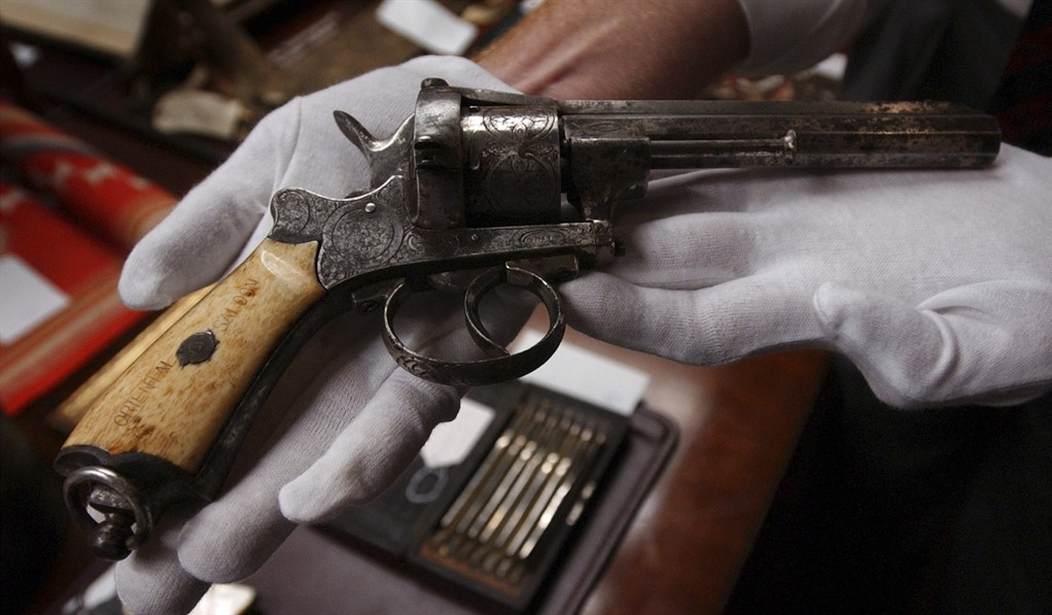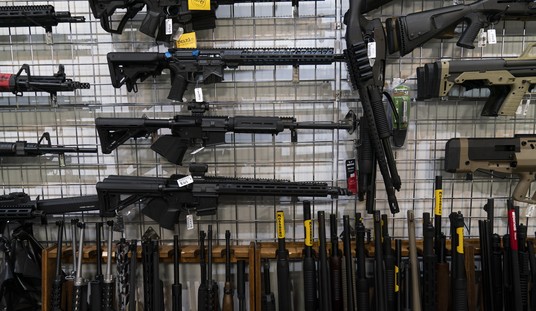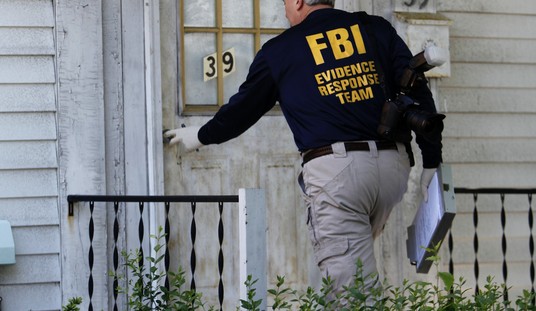A recent podcast that’s produced by The Trace, propaganda put out by little Daddy Bloomberg, went into detail on the alleged myth of the “Wild West.” The rhetoric and conversation seems to be motivated by the ills of marketing and how that was used to change the zeitgeist concerning the west at the time – to sell guns.
Perhaps this is part of a campaign to cast the gun manufacturers in a bad light concerning their modern day marketing efforts, and to push culpability on the gun companies over their advertising? This is a tactic we’ve seen already. In the process of insinuating there were evils in the intent to write a narrative, the hosts of the show actually made solid points for gun ownership, not against it – you can decide for yourself.
The Gun Machine is The Trace’s new podcast. In their third regular episode, “How the Mass Market Was Won,” the hosts, Alain Stephens and Grace Tatter, and their guests, Carney Saupitty and John Bainbridge, discuss the alleged myth of the Wild West. Stephens introduced Saupitty, “Carney Saupitty is the cultural director at the Comanche Nation Cultural Center in Lawton, Oklahoma.”
“The Comanche had also taken another implement from their white enemies pushing in from the east: The gun. By integrating single-shot pistols and rifles with their already established arsenal of lances and bows, the Comanche had turned every warrior on horseback into a mobile weapons platform.” – Alain Stephens
The rhetoric that follows perhaps doesn’t illustrate their arguments well when following such an introduction. Did the Comanche need firearms or not? Did the “white enemies” need their firearms? Let’s assume the Comanche are the protagonists of Stephens and Saupitty’s narrative – it sure seems that way.
Bainbridge, who is a writer, was described as “a journalist and author of Gun Barons: The Weapons That Transformed America and the Men Who Invented Them.”
Stephens talked about the Comanche being under-gunned with Bainbridge.
What the Comanche didn’t know was that they had come up against a level of experimental weaponry few people, both white and Brown, had ever encountered before. A weapon that carried six times the rounds of its contemporaries, and boasted 15 times the rate of fire. This was the revolver.
The parallels to modern day arguments are blistering. The revolver, which we can view as the 19th Century AR-15, or high capacity magazine, is being vilified in a sense, through the Monday morning quarterbacking today. Stephens goes straight at the heart of the subject in a segue between guests.
The story of the West wouldn’t be written with a pen, but with a gun — and most of it is a myth. And it’s all because of Colt. I’m Alain Stephens. And you’re listening to The Gun Machine: How America Was Forged By the Gun Industry, a podcast by WBUR and the Trace. In earlier episodes, we’ve told you how there is no gun industry without the government — and there is no America as we know it without the gun industry. How it’s been this way since the launch of the Springfield Armory: the first open-source, government-funded technological resource, a revolutionary partnership between the government and the private sector. But that doesn’t mean being a gunmaker was a license to print money. As the country matured, those guys would have to write a different playbook: One outside of war, outside of fickle government. And it’s a playbook they use even now. Today, we talk about the man who wrote that playbook. Chapter 3: Go West.
The conversation carried on between Stephens and co-host Tatter, turning their attention to Samuel Colt.
Grace Tatter: Colt built this empire by tapping into his spirit of entrepreneurship and innovation. But it wouldn’t have been possible without government spending.
Alain Stephens: Or marketing. And Colt was a master marketer. He didn’t just sell a gun, he sold the myth of what it meant to own one: Self-reliant. Tough. The good guy with a gun. And unapologetically… white.
Grace Tatter: He was selling an image of what it meant to be American at the time.
Any American that subscribes to the ideal of rugged individualism is being told that their way of thinking is predicated on a myth. Naturally, being White is a problem too. The Colt bashing continued on through the program, crescendoing to a point where we’re told again, that the Wild West was never the Wild West, but just being packaged as such.
Alain Stephens: The reality of what firearms have meant to American Indians, and continues to mean today has been obscured by the myths sold to us by people like Colt so he could sell guns, myths that have become so ubiquitous, we forget they’re myths, in part because they’re seared into our cultural memory as the lifeblood of an iconic genre: the Western. First came dime store novels and traveling shows. Think Buffalo’s Bill Wild West and Annie Oakley. Then… came the movies.
The labor of navigating through the conversation does have a point. If the Wild West never was the Wild West, as the anti-gunners are alleging, then they can’t reference it during today’s arguments.
We’ve been approached with the falsehoods where areas that switch over from may-issue to shall-issue, or shall-issue to permitless carry; all will descend into a state of chaos. Colloquially, the anti-civil right crowd will invoke the Wild West for their imagery. They can’t have it both ways by saying the whole thing is a fabrication, but then cite it as a possible outcome when restrictions are removed from civil liberties. Spoiler alert, there has been no such Wild West activity in any of the states that aligned themselves more closely with the Constitution.
Before concluding, Stephens made some more statements, and one really stood out to me. Stephens stated an often repeated falsehood, and this we need to call out.
Alain Stephens: You might ask: How did a story that started with Samuel Colt end up here? How is it all related? And that’s the thing. It’s complicated, but it all is. It almost seems like you can’t pick up a single thread of American history without tugging on guns. We know that, from Samuel Colt’s multi-shot revolver onward — guns have gotten way better at doing what they’ve always been intended to do: Killing. And we know that you’re more likely to die from a firearm-inflicted wound if you have a gun in your house. And we know that, because of the mass manufacturing of the 19th century, and because of the appetite for guns whetted by all sorts of cultural forces, guns in America are really easy to get. What we don’t know is how to untangle this knot — of the unerasable parts of our history, of our cultural identities, of money, and of death. Next time, we talk about another consequence of creating a mass civilian market for guns, especially the most advanced and the most lethal: crime.
I reached out to Stephens about the statement. I opened my correspondence noting that I’m a freelance writer who covers the Second Amendment.
I cover Second Amendment news extensively as a freelance writer. I stumbled upon the podcast episode “How the Mass Market Was Won,” and wanted to ask you about one of the statements you made.
Towards the end of the conversation, you note:
“And we know that you’re more likely to die from a firearm-inflicted wound if you have a gun in your house.”
This “statistic” has repeatedly been debunked on more than one occasion. Unless I’m missing something here, could you please provide me with a citation for this claim?
I’m considering writing an opinion piece on this show, and I welcome your input.
Thank you for your time and consideration.
I don’t think that was an unfair or uncivil question/query. If you had to guess it, Stephens did not reply to my question, and that non-answer tells us everything we need to know. The statistic is bullshit, we know it, they know it, and they still quote it.
Scholar Dave Kopel put this to bed in 2001 in his paper “The Fallacy of ‘43 to 1.” Author Larry Correia pointed this out in his book “In Defense of the Second Amendment,” on pages 79 and 80.
[The anti-gunner’s] goal is to toss out something that sounds lurid and ghastly, truth be damned, and by the time it is debunked it doesn’t matter, because liars and useful idiots will just regurgitate it forever. Like the infamous “a gun in the home is forty-three times more likely to kill you or a loved one than an intruder.” That one is straight up nonsense, created with embarrassingly flawed methods, from a tiny sample, that even the author has since revised down to a tiny fraction of that (and he’s still grasping at straws to get there), yet they’ve been unabashedly repeating this thoroughly debunked lie since 1986.
The irony of course is that the anti-gunners will use or call out whatever myths are convenient to them at the time. If it makes sense to claim a state will turn into the Wild West if there are more permits granted or none required at all, then they’ll do it. If it suits them to say that was all a myth and has more to do with western expansion and racism – we can’t forget the racism, then they’ll do that. And, if it suits them to quote a garbage “statistic,” they will.
This exercise did expose a real myth; the one that proclaims The Trace is to be regarded as straight “journalism.” Wild West be damned, or honored – anti-gunners full speed ahead!








Join the conversation as a VIP Member